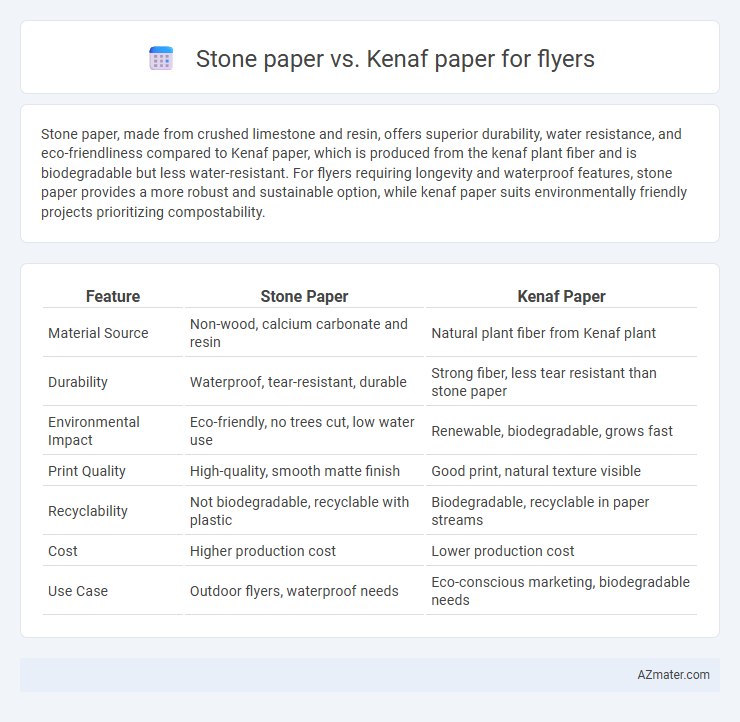Stone paper, made from crushed limestone and resin, offers superior durability, water resistance, and eco-friendliness compared to Kenaf paper, which is produced from the kenaf plant fiber and is biodegradable but less water-resistant. For flyers requiring longevity and waterproof features, stone paper provides a more robust and sustainable option, while kenaf paper suits environmentally friendly projects prioritizing compostability.
Table of Comparison
| Feature | Stone Paper | Kenaf Paper |
|---|---|---|
| Material Source | Non-wood, calcium carbonate and resin | Natural plant fiber from Kenaf plant |
| Durability | Waterproof, tear-resistant, durable | Strong fiber, less tear resistant than stone paper |
| Environmental Impact | Eco-friendly, no trees cut, low water use | Renewable, biodegradable, grows fast |
| Print Quality | High-quality, smooth matte finish | Good print, natural texture visible |
| Recyclability | Not biodegradable, recyclable with plastic | Biodegradable, recyclable in paper streams |
| Cost | Higher production cost | Lower production cost |
| Use Case | Outdoor flyers, waterproof needs | Eco-conscious marketing, biodegradable needs |
Introduction to Stone Paper and Kenaf Paper
Stone paper is a sustainable alternative made from calcium carbonate and non-toxic resin, offering water resistance and durability ideal for flyers. Kenaf paper, derived from the kenaf plant fibers, provides an eco-friendly option with a natural texture and high tensile strength. Both materials reduce environmental impact compared to traditional wood pulp paper, making them popular choices for eco-conscious flyer printing.
Material Composition: Stone vs. Kenaf Fiber
Stone paper is made from crushed limestone combined with non-toxic resins, resulting in a durable, water-resistant material with a smooth texture ideal for flyers requiring high print quality. Kenaf paper consists of natural fibers derived from the kenaf plant, offering a biodegradable and eco-friendly option with a slightly rough texture that enhances ink absorption and tactile engagement. The mineral-based composition of stone paper provides tear resistance and longevity, while kenaf fiber contributes to sustainability through renewable plant resources and reduced environmental impact.
Environmental Impact Comparison
Stone paper, made from calcium carbonate bonded with non-toxic resin, significantly reduces deforestation and water usage compared to Kenaf paper, which is derived from the fibers of the Kenaf plant and requires extensive agricultural resources. Kenaf paper production involves higher water consumption and land use, yet it is biodegradable and compostable, while stone paper offers waterproof and tear-resistant properties but has limited recyclability options. Evaluating lifecycle assessments reveals Kenaf paper's advantages in biodegradability and carbon sequestration during growth, whereas stone paper excels in reducing resource depletion and pollution associated with traditional wood fiber paper.
Production Process Differences
Stone paper is produced using calcium carbonate bonded with non-toxic resin, eliminating the need for water, trees, or bleaching chemicals in its manufacturing process. Kenaf paper is derived from the fibrous core of the kenaf plant, processed through traditional pulping methods that involve water, mechanical or chemical treatments, and energy-intensive refining. The production of stone paper emphasizes eco-friendly techniques with lower water and energy consumption, while kenaf paper relies on agricultural biomass and established fiber extraction and pulping processes.
Print Quality and Ink Absorption
Stone paper offers superior print quality with smooth, non-porous surfaces that enhance ink vibrancy and sharpness, making it ideal for high-definition flyers. Kenaf paper features a more fibrous texture, resulting in moderate ink absorption that can cause slight bleeding and less crisp image details. For flyers requiring vivid, precise prints, stone paper is preferred, while kenaf paper suits eco-friendly options with acceptable print fidelity.
Durability and Water Resistance
Stone paper offers superior durability and water resistance compared to kenaf paper, making it ideal for flyers exposed to harsh environmental conditions. Its synthetic mineral composition ensures tear resistance and moisture-proof qualities, while kenaf paper, derived from natural fibers, tends to absorb water and degrade faster. For long-lasting flyers in wet or high-traffic settings, stone paper provides enhanced performance and longevity.
Cost Efficiency Analysis
Stone paper offers higher initial production costs due to its synthetic composition but delivers long-term cost savings through durability and water resistance, reducing replacement frequency for flyers. Kenaf paper, derived from natural fibers, generally incurs lower startup expenses and biodegrades efficiently, making it cost-effective for short-term flyer campaigns. Evaluating total expenses, Stone paper suits high-volume or reusable flyers, while Kenaf paper is optimal for eco-conscious brands prioritizing budget-friendly, sustainable print solutions.
Biodegradability and Recycling Options
Stone paper, made from calcium carbonate and resin, offers water resistance but is not biodegradable and poses challenges for traditional recycling processes, often requiring specialized facilities. Kenaf paper, derived from the fibrous kenaf plant, is fully biodegradable and integrates easily into standard paper recycling streams, making it an eco-friendlier choice for flyers. The environmental impact of flyers is minimized with kenaf paper due to its sustainable growth and decomposition properties compared to stone paper's reliance on non-renewable minerals.
Applications: Suitability for Flyers
Stone paper offers exceptional durability and water resistance, making it ideal for outdoor or high-traffic flyer distribution where longevity is crucial. Kenaf paper provides excellent print quality and biodegradability, fitting environmentally-conscious brands seeking sustainable flyer materials with a natural texture. Both options are suitable for flyers, but stone paper excels in weather resistance while kenaf paper prioritizes eco-friendliness and recyclability.
Final Verdict: Choosing the Best Paper for Flyers
Stone paper offers superior water resistance and durability, making it ideal for flyers requiring longevity and outdoor use. Kenaf paper provides an eco-friendly alternative with a softer texture and excellent print quality, suited for environmentally conscious brands prioritizing sustainability. For flyers that demand robustness and moisture resistance, stone paper is the best choice, while kenaf paper excels in biodegradable, high-quality prints emphasizing green marketing.

Infographic: Stone paper vs Kenaf paper for Flyer
 azmater.com
azmater.com